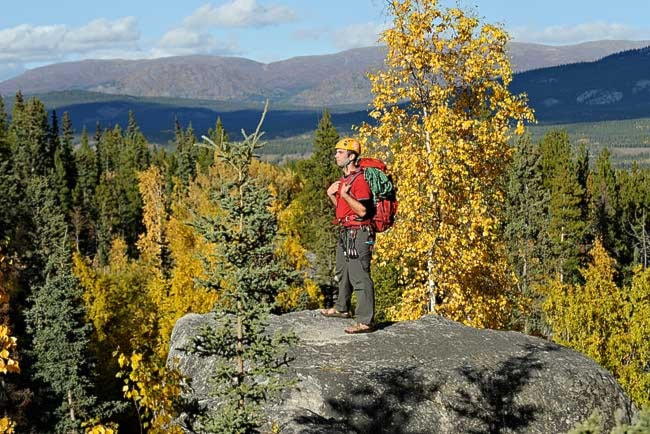Yukon’s best rock climbing areas are no longer esoteric and the route names of particular climbs are no longer in dispute. At least that’s a couple goals of the first edition of the Yukon Climbing Guide, which was officially released on Wednesday.
“I’m really excited about this and I think all the climbers are as well,” said Ryan Agar, author of the 94-page guide. “So much of the information is wrapped up in people’s heads, trying to figure out where things are, or what things are named, or where a specific area or climb is, is its aim.”
Agar remembers when he first started climbing six years ago, after the friend who introduced him to the sport left for university, he didn’t know where to turn for information on rock climbing in the territory.
“I was left hanging, going, ‘I don’t know what to do now - where do I go looking for information?’” said Agar. “I taught myself out of a book, I spent a lot of time chasing cliffs, and I thought, ‘This is a bad way of doing this.’”
To keep new climbers, or experienced climbers new to the Yukon, from falling into the same boat, Agar began his research for the guide - and not through countless Google searches.
[image2]
Hiking was a major part his research. So was speaking with local climbers.
“It led to lots of exploring and not a lot of climbing,” said Agar. “So this is a really nice collection of all that information that’s wrapped up in people’s heads, in one place, with good directions and GPS co-ordinates and the whole nine yards.
“Looking at topographical maps or aerial photos and going, ‘That looks cliffy, I’ll go take a look at that.’ Sometimes it pans out and sometimes it doesn’t.”
The guide covers 16 climbing areas in detail from Dawson City to Haines to Skagway to northeastern BC, with an additional eight given, “as an option for people to go and explore.”
It provides photos, histories, directions, GPS co-ordinates and descriptions including levels of difficulty. It also provides route names on rock faces and thereby might put to rest on-going arguments about what certain climbs are called.
“Once you find a climbing area, then there’s finding out who put up the first ascent,” said Agar. “There are a lot of conflicting reports. Some people are like, ‘I climbed that in ‘93 and called it this.’ And another person says, ‘I climbed that in ‘92 and I called it this.’
“At the end of the day, this is like a stake in the ground saying, ‘Here’s where we are today - here’s what I believe to be true today.’ And it gives us something to organize around.
“But there’s so much left to do.”
Even before going to print, the guide was getting used. Greg Oldridge, who moved to Whitehorse in the spring and leads rock climbing expeditions with Equinox Adventure Learning, would press Agar for unpublished pages to help with his tours.
“I found it a little bit hard, at first, to find places,” said Oldridge. “It’s always a bit unnerving when you see something that you want to try, but it could be way out of your ability. It’s nice to have something to look at and go, ‘This is at that grade, and I know I can climb at around that grade.’
“We take all sorts of people out; we take adults out, we take school groups out, kids five to seven years old - so they’re tiny. And we pick the sites based on what the age and experience of the people are.”
The Yukon Climbing Guide, which has been in the works for three years, is completely locally made, designed locally and printed locally with images from local photographer Gary Bremner. It can be purchased for $25 at local venders including Mac’s Fireweed Books, UpNorth Adventures, Coast Mountain Sports and Well-Read Books, plus the Mountain Shop in Skagway.
“The Yukon has a long history of technical rock climbing, which is what this book is focused on,” said Agar.
“As far back as the ‘70s is the first established climbing area in the territory, so it’s been going on for a long time. And a lot of that information is just, I know a guy, who knows a guy, who knows where a cliff is. That’s the way it’s been for quite a while.
“It’s really awesome to see a resurgence of the community coming back, and a key part of that is going to be having a resource for people to get out to the crags, knowing where to go and how to get there.”
More information, and updates for the second edition, can be found at Climb Yukon’s website at climbyukon.net.
Contact Tom Patrick at
tomp@yukon-news.com
